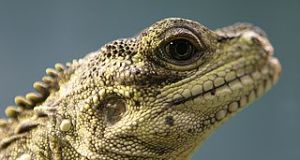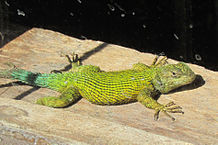While work ing with Green Anacondas in the central Venezuela llanos (please see my article Hunting Anacondas in the Venezuelan Llanos) in the late 1990’s, I was delighted to find that Black Tegus, one of my favorite lizards, were quite common in the area. Sometimes referred to as “New World monitor lizards”, it was indeed hard not to make that comparison when watching tegus hunting. Active and intelligent, these stout lizards ate just about everything they came across – other lizards, snakes, turtle and bird eggs, small mammals, fish, frogs, crabs, large insects and carrion – and were major predators in this flooded grassland habitat. I managed to catch a few young tegus, but old, battle-scarred individuals were impossible to approach, fleeing with amazing speed at the slightest move in their direction.
ing with Green Anacondas in the central Venezuela llanos (please see my article Hunting Anacondas in the Venezuelan Llanos) in the late 1990’s, I was delighted to find that Black Tegus, one of my favorite lizards, were quite common in the area. Sometimes referred to as “New World monitor lizards”, it was indeed hard not to make that comparison when watching tegus hunting. Active and intelligent, these stout lizards ate just about everything they came across – other lizards, snakes, turtle and bird eggs, small mammals, fish, frogs, crabs, large insects and carrion – and were major predators in this flooded grassland habitat. I managed to catch a few young tegus, but old, battle-scarred individuals were impossible to approach, fleeing with amazing speed at the slightest move in their direction.
One morning I was scanning an area where I had seen a pair of Giant Anteaters a day earlier, hoping for another look, when my binoculars picked up a co-worker doing what appeared to be an odd dance of sorts. Upon closed inspection, I saw that he was repeatedly jumping back from a yard-long black animal that was hurling itself at his leg.
I ran over and found him in a pitched battle with a large male Black Tegu. The animal was not cornered and had ample opportunity to turn and run, as they invariably do, but simply refused. Nest-guarding has been reported in some populations, but among females only and there was no nest to be found here. Upon subduing the ornery fellow I found that he was uninjured, and capable of moving normally.
The only explanation that seemed to make any sense (outside of a bad temper!) was that he had not warmed sufficiently for a fast burst of speed (it was morning, and the lizard was in grass flooded by cool water). However, he seemed to be exerting as much energy fighting as he would have by running! Upon being released, he continued to hold his ground until we relinquished what was obviously a prized piece of real estate.
Of course, there are general rules as to typical species’ behaviors, but reptiles and amphibians show quite a variance in “personality traits” – this may assist them in adapting to changing environmental conditions and to captivity. .
An interesting article on Black Tegus and related species is posted at:
http://www.reptilia.net/articulos_ing/027.pdf
 That Reptile Blog – Reptile, Amphibian and Exotic Pet Care and Information
That Reptile Blog – Reptile, Amphibian and Exotic Pet Care and Information



